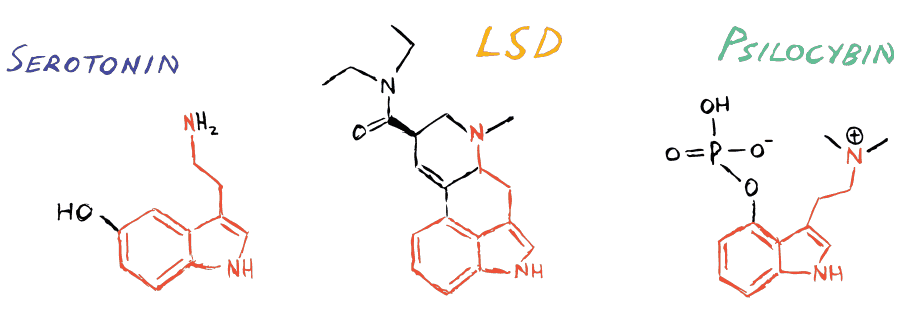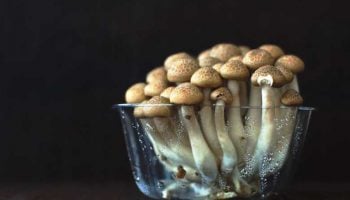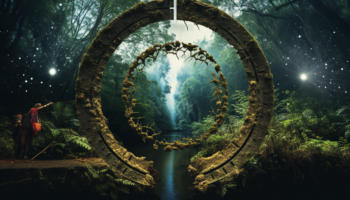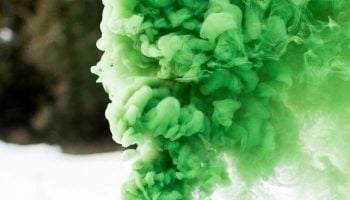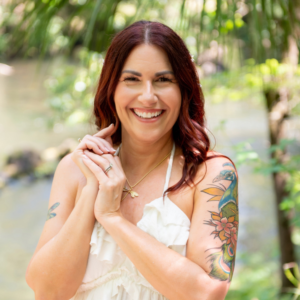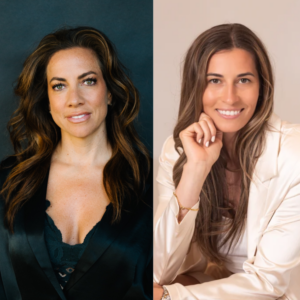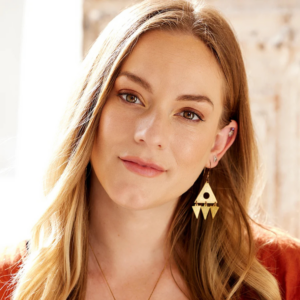The Ultimate Guide to
Microdosing
Ayahuasca
Aya, Huasca, Yagé, Kamarampi, Huni, Brew, Daime, The Tea, La Purga
Ayahuasca is a potentially illegal substance, and we do not encourage or condone the use of this substance where it is against the law. This guide is designed to ensure the safety of those who decide to use the substance legally.
Overview
01Ayahuasca is an entheogenic brew or tea made from the Banisteriopsis caapi vine and the Psychotria viridis leaf. It is used in traditional ceremonies among the indigenous tribes of Amazonia. P. virdris contains DMT, which is a powerful psychedelic compound, and B. caapi contains monoamine oxidase inhibitors (MAOIs), which work synergistically with DMT to produce a long-lasting psychedelic experience. Though macrodoses of ayahuasca are more commonly known, shamans also have a history of microdosing the substance.
Studies are showing that ayahuasca therapy may be effective in treating depression and addiction. As this ancient brew becomes more mainstream, we may see it become a widespread and accepted form of psychedelic therapy.
To learn more about ayahuasca, read our Essential Guide to Ayahuasca.
Master the Skill of Microdosing
Enter your info to start your journey on Third Wave's Microdosing Course! Discover a science-based framework for transformational microdosing.
"The course gave me hope, a new way from what I've read and researched before. It has content which any reader can relate to whether you're an addict, an alcoholic or someone suffering from depression or other mental or spiritual ailments. I now feel empowered to take responsibility for my life!"
-Melissa P.
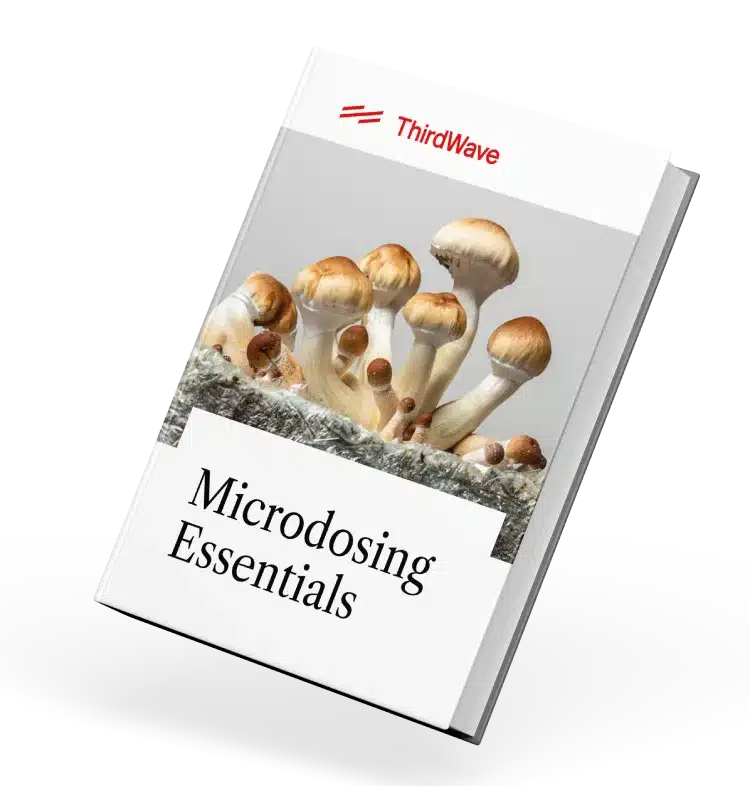

Master the Skill of Microdosing
Enter your info to start your journey on Third Wave's Microdosing Course! Discover a science-based framework for transformational microdosing.
"The course gave me hope, a new way from what I've read and researched before. It has content which any reader can relate to whether you're an addict, an alcoholic or someone suffering from depression or other mental or spiritual ailments. I now feel empowered to take responsibility for my life!"
-Melissa P.
Experience
02How to microdose with ayahuasca
Though microdosing LSD and psilocybin is more common, microdosing ayahuasca is also possible and effective. However, taking into account the large variety of ways to prepare an ayahuasca brew and highly individual responses to consumption, determining the specifics of dosage and content is a matter of experimentation.
An alternative to brewing tea is the pharmahuasca route, or making a pharmaceutical ayahuasca analog.[1] This method is not only less time-consuming; it also allows for the precise measurement of the ingredients.
The first part of the recipe involves using an extracted MAOI, most often one of the three harmala alkaloids found in Banisteriopsis caapi or Syrian Rue: harmaline, harmine, or tetrahydroharmine. The second part is extracted freebase DMT. The MAOI is ingested in a plastic capsule and the DMT is taken some 20 minutes afterward, after soaking in lemon juice for conversion to DMT citrate.
Personal accounts have suggested that vomiting may follow this type of intake.[2] And some suggest that DMT can also be ingested in a pill as long as the harmala contents are properly dosed.[3]
To make a microdose of ayahuasca, you first need to make a full-strength brew. The ingredients necessary for this are as follows:
MAOI
- 50-60g Banisteriopsis caapi leaves, shredded;
- (or) 4-5g Syrian Rue seeds, crushed/ground;
- (or) 100-200mg of extracted harmalas.
DMT
- 25g Psychotria viridis leaves, dried and ground;
- (or) 9g Mimosa hostilis/tenuiflora root bark;
- (or) 20g Acacia acuminata/confusa/phlebophylla leaves/root bark;
- (or) 75mg N,N-DMT.
After creating this brew, it’s up to you to determine the ideal microdose. We recommend starting by drinking between a tenth and twentieth of the total volume of the brew. If you don’t notice anything after several hours, during your next attempt you can slightly increase the dose until the onset of perceptible effects. Once you’ve found that threshold dose, roll it back to just under this threshold for a correct microdose.
As mentioned, ayahuasca’s effects (and side effects) vary in presence and strength among individuals. So, start with a low dose.
This approach applies especially to the DMT portion; the ayahuasca vines/MAOIs are the actual healing agent and the microdosing should have a more purposeful role if it is geared toward healing rather than tripping. Omitting the DMT contents for starters and consuming a purely MAOI-based concoction is also encouraged, and it’s in line with shamanic traditions where DMT visions come secondary to the vine’s healing properties.
What schedule should I follow?
As with dosage, timing should be a matter of preference and one’s individual response. Experts in this area suggest different microdosing regimens, but our microdosing course follows James Fadiman’s system. Fadiman recommends taking a microdose once every three days: Take a microdose on Day 1. Then, do not take a microdose on Day 2 or Day 3. On Day 4, take another microdose.

Continue this process for several weeks.
For most people, morning is the best time because the beneficial effects will last throughout the day without interfering with sleep. It’s also helpful to take daily notes in a journal to observe the effects throughout this process and adjust accordingly—or just notice the positive changes.
It’s also important to follow your usual routine while microdosing. The purpose is to enhance your day-to-day existence by integrating microdoses into your routine, so don’t change what you normally do. However, when you try microdosing for the first time, take a day off from work and social commitments. This will give you a chance to notice any unusual effects before microdosing in a more public situation.
While it may seem like you would only feel the effects of the microdose on the days you actually take it, try to observe the effect on the two days between doses, too. Many people perceive increased feelings of flow, creativity, and energy the day after they microdose in addition to the day of microdosing.
Since the effects of ayahuasca are reportedly cumulative, 48 hours should be the minimal repetition interval—we don’t recommend taking it every day.
Effects
03Pharmacology
The ayahuasca tea is brewed using two separate plants: B. caapi and P. viridis. The P. viridis plant contains the single major psychedelic alkaloid, DMT. The B. caapi plant contains the MAOIs that allow DMT to have its psychoactive effect. These MAOIs include harmine, tetrahydroharmine (THH), and harmaline, among others.[4]
The concentration of the alkaloids in brewed ayahuasca tea is several times greater than the plants from which they are prepared. In a 200 ml dose, there is an average of 30 mg harmine, 10 mg THH and 25 mg DMT, though concentrations will vary based on the geographical region and preparation methods.
Ayahuasca is notorious for causing diarrhea and vomiting, which could be a contributing factor to the brew’s healing capabilities—researchers believe psychedelics might change your mind by changing your gut. An imbalanced gut microbiome has been linked to several psychological disorders, including autism, anxiety, and depression—the same issues for which psychedelics are increasingly thought to be a treatment.
The science of microdosing
While there has been some recent research on microdosing, we know a lot more about what large doses of psychedelics do to the brain.
Much of what we understand about how psychedelics work involves serotonin, a chemical that is among the brain’s most important neurotransmitters. Serotonin affects nearly everything we do, from how we feel to how we process information. It keeps our brains ticking.
Psychedelics such mescaline share a similar structure to serotonin and mimic the chemical’s effects. This is why these substances have comparable effects to a full dose when microdosed, at least in the most important aspects.
Learn more about the differences between microdosing LSD and psilocybin here.
Because serotonin is so important to mood stabilization, common antidepressants (called Selective Serotonin Reuptake Inhibitors, or SSRIs) increase the levels of serotonin in the brain, which can make you feel happier.
Psychedelics work more directly by mimicking serotonin. One of mescaline’s main effects, for example, is to stimulate the 5-HT2A serotonin receptor located in the prefrontal cortex, which leads to two important results:
- The production of “Brain-Derived Neurotrophic Factor” (BDNF), a protein that is “like Miracle-Gro for your brain,” according to author and microdosing proponent Ayelet Waldman. BDNF stimulates growth, connections, and activity. [5]
- The increased transmission of “Glutamate,” a neurotransmitter responsible (in part) for important brain functions such as cognition, learning, and memory. [6]
Glutamate and BDNF work together in ways we’ve yet to fully understand, but it’s become clear psychedelics also cause parts of the brain that don’t usually communicate with one another to start talking, so to speak. These unique connections are formed by psychedelics’ ability to dampen the activity of an often overused part of our brain called the “Default Mode Network” (DMN). [7] The DMN is responsible for many mental activities, including day-dreaming, self-reflection, and thinking about the past or the future.
Research shows that a highly active DMN causes us to ruminate, over-analyze ourselves, and step out of the present moment to question the past and the future, all of which can make us unhappy. In fact, some studies suggest that depression is linked to an overactive DMN. [8] This helps explain why psychedelics could be used to combat depression and anxiety—as well as lead to insights and creative perspectives that may otherwise remain inaccessible.
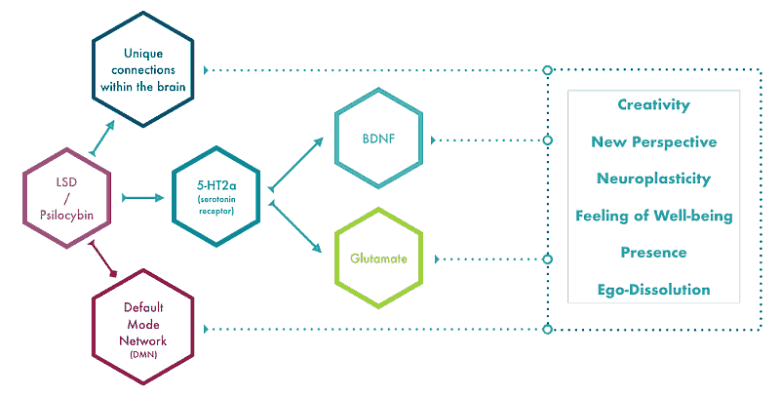
Get Your FREE Ultimate Guide To Microdosing for Depression.
Sometimes hope comes in micro-doses. This guide will walk you through the process and how to best use the healing potential of psychedelics in a safe, intentional way to heal depression.
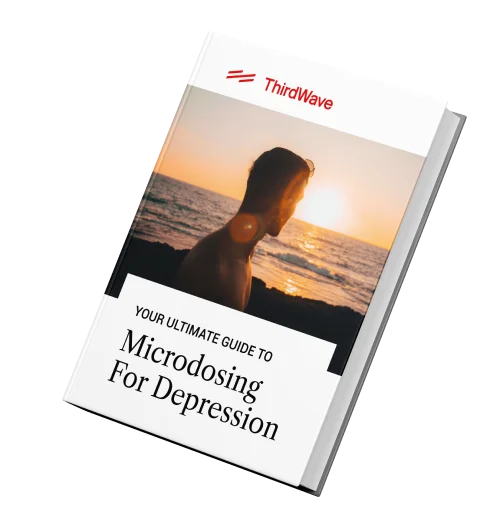

Get Your FREE Ultimate Guide To Microdosing for Depression.
Sometimes hope comes in micro-doses. This guide will walk you through the process and how to best use the healing potential of psychedelics in a safe, intentional way to heal depression.
Benefits & Risks
04Potential Benefits
Ayahuasca has been central to the spiritual and religious ceremonies of Amazonian tribes for centuries, where it has long been viewed as an agent for healing and change. In the western world today, the substance has become popular among people seeking to open their minds, heal past traumas, or gain deeper insight into themselves and their connections. As the old and new worlds collide, experts and practitioners are now bridging science and spirituality as a critical element to understanding Ayahuasca’s powerful benefits.
Many people who have taken ayahuasca say the experience led to positive, long-term, and life-altering changes. Though research into the effects of microdosing ayahuasca is extremely limited, anecdotal evidence suggests that these benefits may be possible with small, sustained doses, too.
Self-experimenters have reported depression and anxiety relief, daily life insights, reduced stress, increased awareness, compassion, satisfaction, peace, a sense of acknowledgment, and emotional discharge. There are differing accounts of the effects on creativity, focus, social ability, and sexual energy. But for many, these aspects are positively enhanced. [9][10]
Risks
While there is very little formal research on the safety of ayahuasca, it is largely considered a safe drug. A few deaths have been reported in relation to ayahuasca ceremonies, but these were usually due to undiagnosed heart conditions, interactions with other drugs, or the use of other substances. Death has never been reported in a clinical trial of ayahuasca.
The greatest risk associated with ayahuasca use is the substance’s interaction with other drugs. Ayahuasca can interact dangerously with many medications, including antidepressants, psychiatric medications, cough medicines, appetite suppressants, and more. Ayahuasca could also worsen the symptoms of psychiatric disorders, such as schizophrenia. Those with a history of these disorders should avoid ayahuasca.
Ayahuasca can also increase heart rate and blood pressure. If you have a heart condition, this could result in dangerous side effects.
Other risks include the unpleasant side effects that many people experience after consuming ayahuasca, including vomiting, diarrhea, paranoia, anxiety and panic. Though these effects can be distressing, they are normal and temporary.
Even though microdosing shouldn’t warrant a full ayahuasca diet, some foods can be dangerous in combination with MAOIs and dietary precautions are advised. Avoid aged cheeses, cured meats, soy sauce, fermented foods (like tofu), pickled vegetables, spicy foods, alcohol in general (especially red wine), aspartame, and large amounts of dark chocolate.
Therapeutic Use
05With appropriate supportive settings that include talk therapy and social network support, regular and long-term use of ayahuasca may be the catalyst for lasting lifestyle changes. This is most notable with respect to substance abuse and addiction. One study of an ayahuasca ceremony in Canada, for example, found significant effects on the treatment of addictive behaviors.[12] In a qualitative study surveying a group of people who joined the ayahuasca church UDV (an organization that regularly uses the brew in their religious ceremonies), a large number of the members had histories of alcoholism, substance abuse, domestic violence, and other problem behaviors and lifestyles. These dysfunctional behaviors were virtually resolved after joining the UDV and attending regular ceremonies.
A government-approved addiction treatment center in Peru has integrated ayahuasca into its methodology and has shown significant results among hundreds of patients. Recent animal studies have also shown that ayahuasca-assisted psychotherapy can help eradicate substance abuse disorders.
Ayahuasca may also help ameliorate serotonin deficiencies, which have been related to a host of different disorders, including alcoholism, depression, autism, schizophrenia, attention deficit hyperactivity disorder, and senile dementia. Some small studies suggest that long-term ayahuasca use can possibly increase serotonin availability in the body.[11]
Listen to our podcast episode with Rachel Harris talking about: Overcoming Trauma With Ayahuasca or Click here to read the transcript
The first study to analyze the antidepressant properties of ayahuasca in a controlled setting also showed promising results.[13] Twenty-nine patients with severe depression were given either one session of ayahuasca or a placebo, then analyzed for changes in their depression scores. One day immediately following the sessions, the ayahuasca group scored significantly lower on depression tests compared to the placebo group. After seven days, the placebo group had returned to a normal depression level, while the ayahuasca group still reported a much lower depression score.
Though more research is needed to understand the efficacy of ayahuasca to treat PTSD, anecdotal evidence suggests it could be beneficial. For example, the recent documentary From Shock To Awe follows two war veterans suffering from PTSD as they abandon pharmaceuticals and seek healing through ayahuasca. By the film’s end, the two men have seen their traumas melt away.
It’s important to remember that if ayahuasca does have therapeutic value (which it almost certainly does), gleaning the most healing benefit possible requires the use of ayahuasca in a safe, therapeutic, and supportive environment. Drinking the brew alone at home will most likely not yield the desired results. We recommend considering an ayahuasca retreat, where you are surrounded by supportive people in a comfortable environment.
See our Essential Guide to Ayahuasca Retreats for information about the benefits of ceremonies, along with advice on how to choose, what to expect, and more.
Personal Growth
06Many who seek personal growth through ayahuasca report a sense of connectedness and compassion with others around them.[15] Some report spiritual awakenings that lead to long-term, stable shifts in perspective. This is likely the result of accessing intense levels of introspection, which leads to profound self-awareness and personal clarity.[16][17] Dennis McKenna also cites ayahuasca’s ability to make users feel interconnected with the natural world as a possible avenue for the expansion of discussions around environmental conservation.[18]
Ayahuasca has also seen a surge in popularity among entrepreneurs and creatives, which is making its way into mainstream culture. As one New Yorker article puts it, “If cocaine expressed and amplified the speedy, greedy ethos of the nineteen-eighties, ayahuasca reflects our present moment—what we might call the Age of Kale.”[19]
Tim Ferriss is also a vocal advocate of ayahuasca. After a particularly harrowing ayahuasca trip that included grand mal seizures and hyper-anxiety inducing hallucinations, Ferriss claims that “ninety percent of the anger I had held onto for decades, since I was a kid, was just gone. Absent.”[20] He also claims that almost everyone of any influence in the startup industry uses ayahuasca at some point.
In fact, many ayahuasca retreats have been developed specifically for entrepreneurs looking to unlock leadership skills and creativity. Entrepreneurs Awakening and 1heart Journeys, for example, have helped hundreds of leaders find their purpose and learn to better execute it. “Since the program, I feel much more in line with my purpose,” one Entrepreneurs Awakening participant said. “As a result, my business and I are more aligned and making risky decisions is easier…this has made me a much more effective mentor and leader.”
In general, ayahuasca could also be a powerful tool for igniting creativity. For decades, artists, writers, designers and computer programmers have touted the benefits of psychedelics as creative aides. In a landmark study on mescaline and creativity in the 1960s, the psychologist James Fadiman had 27 engineers, mathematicians and architects work on an unsolved professional problem while on mescaline. The majority of the participants found concrete solutions to their problems and considered the session very helpful. More recently, a study from the Beckley Foundation found that ayahuasca increases divergent thinking, which is one of the hallmarks of creativity.
While these findings pertain to macrodoses of ayahuasca, the intention of microdosing any psychedelic is to reap these benefits in daily life—on a smaller scale, of course. People who microdose ayahuasca have reported increased mindfulness, creativity, well-being, focus, and positive shifts in perception.
Everything you need to know about Microdosing in one place
Download our FREE guide to learn how to begin a microdosing regimen, calibrate your dose level, and get the most out of your experience.
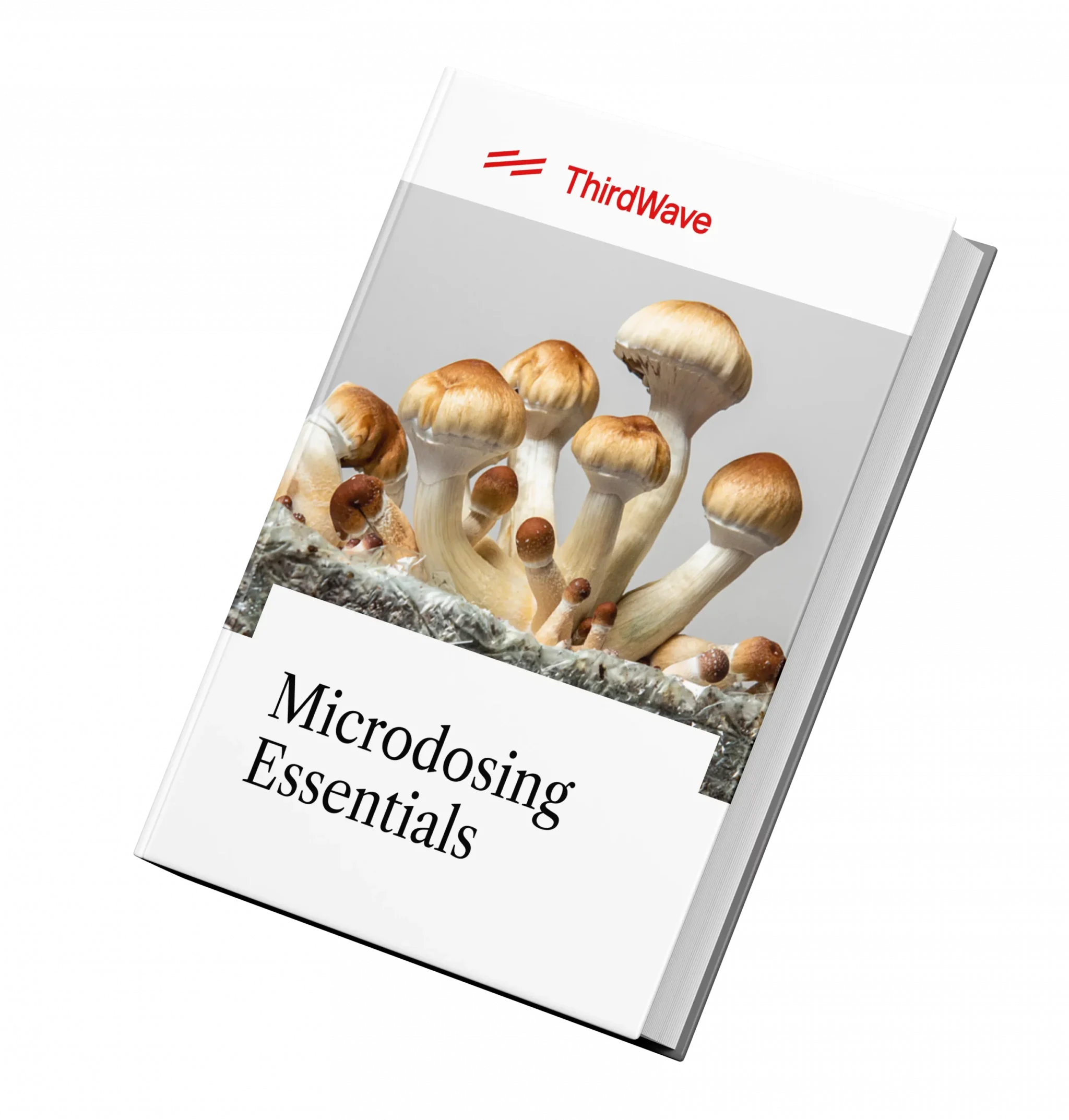
“This FREE Guide was just what I needed to take the first step into Microdosing. AND IT WAS THE BEST DECISION OF MY LIFE! After starting my microdosing regiment I now have more focus, energy and clarity into what it is I truly want in this world.”
James, New York

Everything you need to know about Microdosing in one place
Download our FREE guide to learn how to begin a microdosing regimen, calibrate your dose level, and get the most out of your experience.
Macrodosing
07In addition to opening the door for deeper immersion, placing oneself in an intentional and sacred space has the added benefit of allowing one to commune with the guide and fellow travelers. This can be crucial for integrating the experience. The shaman also serves to invoke the spirits, enrich the ceremony with blessings and sacred melodies, and stabilize it with their vast knowledge of the spiritual realms, while also offering important instruction and care for participants they sense are having troubles. If nothing else, the presence of others can instill a sense of comfort, reassuring us that we’re not alone in seeking growth. And the exchange of accounts afterward can be valuable for understanding what it is that ayahuasca actually does.
This is probably why ayahuasca retreats, in their now standardized three, seven, or twelve-day forms, have become so sought after. They provide a secure and comfortable framework for westerners to relax while they take time to process the experience, often with medical staff on hand, fully vetted shamans, and well-outfitted accommodation. Diet programs are weaved into the retreat structure, as well as a host of activities such as flower baths, sauna time, hot tubs, hiking, yoga, art, and dance workshops.
Inadvertently retreats can also be places that inspire deep healing you never knew you needed. After four to eleven journeys at an Amazonian retreat, participants reported experiencing long-term improvements in various aspects of mental wellbeing. Learn more about the results in our recent Ayahuasca research article.
Legality
08In the US, two religious groups (the UDV and Santo Daime) have been given approval to use ayahuasca as part of their healing ceremonies.
Ayahuasca can also be consumed with relative freedom in the City of Oakland, CA. On June 4, 2019, the city council voted unanimously to decriminalize all “entheogenic plants” containing indoleamines, tryptamines, and phenethylamines. This allows adults aged 21 years and older to use them either medicinally (in accordance with the resolution’s official intent) or for any other reason without fear of criminal punishment. It also specifically decriminalizes (or rather deprioritizes for law enforcement) their cultivation and distribution.[21][22][22][23]
Ayahuasca is legal in Brazil and Peru, and these are the locations of most retreats. Its legal status in other countries is murky, and there are many cases of people being arrested for religious use.
Find out more at our page on the worldwide legality of ayahuasca.
Getting started with psychedelics and finding consistent legal access is a challenge. That’s why we built an online community of trusted providers ranging from therapists to clinics, to retreats. We hope you find what you’re looking for.
Ethical Considerations
09It’s not surprising that the Western world would embrace rituals such as ayahuasca ceremonies. As religions commonly associated with this part of the world are falling out of favor, people seek deeper, more “natural” replacements that cater to the new vision of spirituality rather than dogma. But this mindset can lead to the prevalence of exoticism and the “noble savage” stereotype, which denigrates indigenous cultures while lauding one select cultural practice—the ayahuasca ceremony.
Removing this one aspect of indigenous culture from its roots can cause many problems, both inside and outside that culture. One example is the so-called neo-ayahuasqeuro — a kind of self-styled ayahuasca shaman with very little or no connection to the indigenous cultures that practice ayahuasca ceremonies. While some follow traditional practices, a potentially lucrative market has attracted charlatans and hucksters (both non-indigenous and indigenous), which is cause for concern. Free market exchange for the purposes of monetary gain is often at odds with the traditional indigenous practices of the Amazon, introducing another layer of ethical complexity.
This gets even more complicated given the fact that some indigenous groups see the Western-facing ayahuasca industry as a way to uplift their communities. To them, foreign participation and the expansion of ayahuasca are positive. But then there are those who believe that people outside the traditional lineage should not use ayahuasca at all. To them, ayahuasca use by Westerners is a form of cultural appropriation.[25]
Even the idea of charging for ceremonies is largely contested based on religious tradition. In Brazil, for example, ritual and religious use of ayahuasca is legal but not therapeutic or commercial use. Therefore profiting from this practice is seen as immoral. Another cause for concern is the recent reports of sexual predators pretending to be shamans. This is especially concerning given that ayahuasca tea can treat sexual trauma and/or sexual dysfunction and intimacy problems.
Beyond the appropriation present in the ceremonial use of ayahuasca by Westerners, there’s also the issue of biopiracy—Western pharmaceutical companies have recognized the biosphere as an important source of healing medicines and virtually never credited, let alone compensated, the people who have used these for centuries. Some companies have even sought out shamans who, unaware of companies’ real motivations, have shown them how to source and prepare these plants.[26]
Some point out, though, that the wisdom of the cultures of the Amazon basin will only be spread to all of humanity by bringing in outsiders. The force of globalization can’t be stopped at this point, so ayahuasca and other traditional practices will continue spreading across the planet. It’s up to us outsiders to ensure that it’s done in a more respectful manner than it has been in many cases to date.
Beyond LSD and Psilocybin is a field. This guide will take you there.
In Third Wave’s Ultimate Guide to Safely Sourcing Psychedelics, you will discover an astonishing menu of psychedelic medicines…
…and how to source them without legal risk.
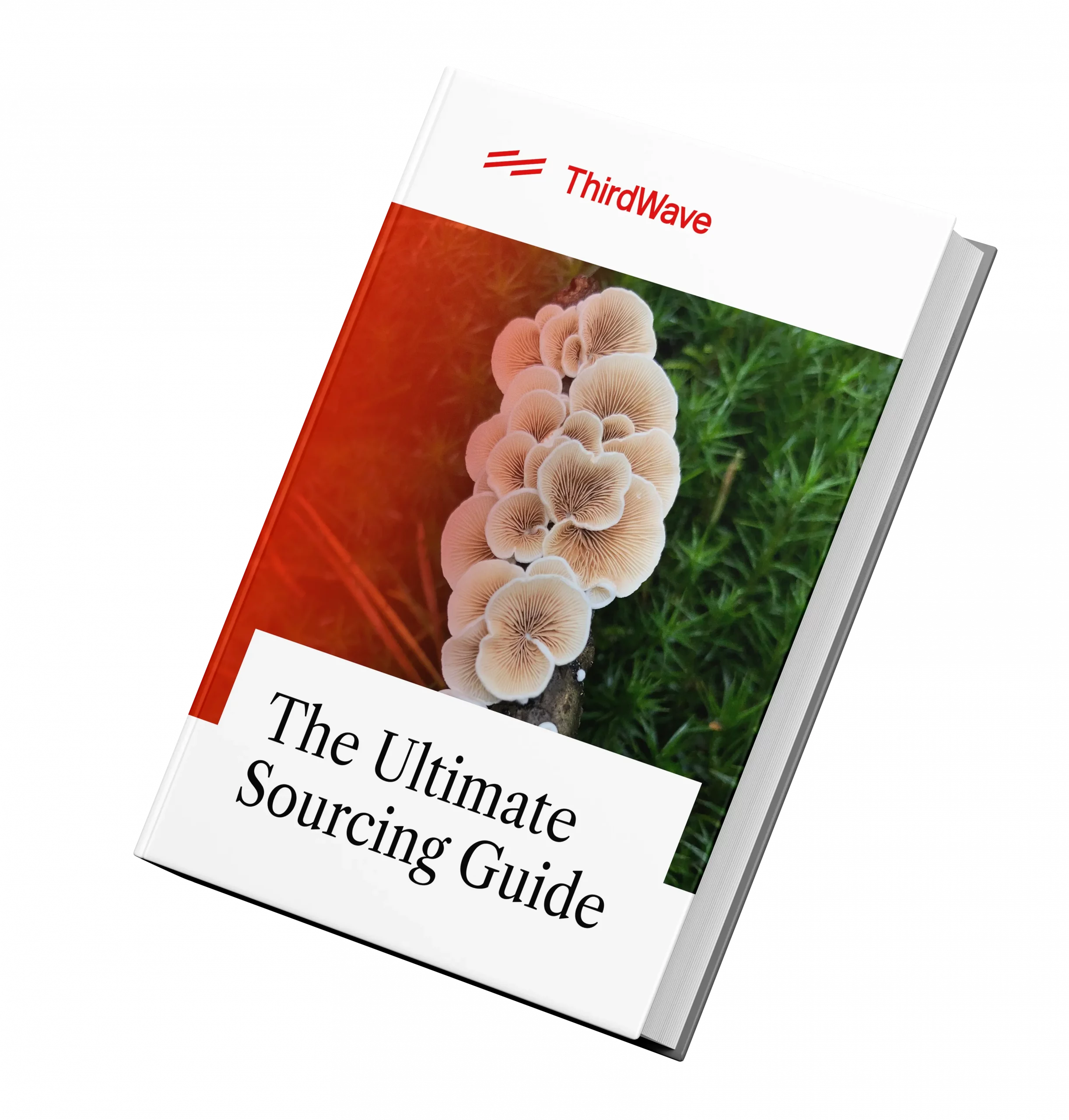

Beyond LSD and Psilocybin is a field. This guide will take you there.
In Third Wave’s Ultimate Guide to Safely Sourcing Psychedelics, you will discover an astonishing menu of psychedelic medicines…
…and how to source them without legal risk.
History
10The use of ayahuasca is an ancient and widespread practice among indigenous tribes in the Amazon Basin. Such practices were almost certainly well established in pre-Columbian times, with some speculating that the practice dates back even further to the region’s earliest human inhabitants. Ayahuasca, along with many other medicinal plants, gradually found its way into the Western world following European contact in the New World.
The therapeutic use of ayahuasca tea is experiencing unprecedented expansion worldwide and is the object of increasing biomedical research. Its constituent plants were central to indigenous cultures in the New World and were used in medicine, religious ceremonies and rites of passage. Throughout the first half of the twentieth century, small groups of indigenous people continued to use these plants in traditional ceremonies and other cultural practices.
Read more about indigenous ayahuasca practices.
These practices continued without interference until recently, likely due to the relative isolation of these groups in the Amazon rainforest. In the 1980s, over 70 different names were recorded for ayahuasca preparations from disparate indigenous tribes, illustrating its widespread use by isolated groups. In Peru, knowledge of the brew has passed from the Amerindian shamans to vegetalistas (mestizo healers), who use it to diagnose and treat patients in the frontier cities of the Amazon.
While DMT is a Schedule I drug in the United States, effectively banning it for all uses including medical and research purposes, several religious groups have litigated and won the right to use it in spiritual or religious practices.
The history of microdosing
While the modern history of psychedelics reaches back to the 1950s, interest in microdosing saw a major revitalization with the publishing of psychologist and psychedelic advocate Dr. James Fadiman’s book, The Psychedelic Explorer’s Guide: Safe, Therapeutic, and Sacred Journeys in 2011, which explores microdosing as a subculture of psychedelic use. While a number of indigenous cultures—as well as modern professionals—have used microdosing to unlock a host of personal benefits, Fadiman’s book formally introduced the term “microdosing” into the mainstream.
Beyond coining the term, The Psychedelic Explorer’s Guide awakened the curiosity and imaginations of millions of people and provided practical information for anyone interested in giving microdosing a try. Much of this information has been integrated into this guide.
Outside of the book, Fadiman’s ongoing research also serves as one of the few modern studies into the effects of microdosing specifically—most current psychedelic research looks at the effects of larger doses on specific therapeutic outcomes.
Following the publication of The Psychedelic Explorer’s Guide, the next boost in the public’s awareness of microdosing came from a podcast interview Fadiman gave with investor and author Tim Ferriss in March 2015. Ferriss, who rose to fame after authoring the bestseller, The 4-Hour Work Week, has an enormous audience of individuals interested in entrepreneurship, “biohacking,” self-experimentation, psychology, spirituality, and other subjects that predispose them to an interest in the benefits of microdosing. The interview boosted Fadiman’s core microdosing messages and created more mainstream interest in the practice: soon after its air date, Ferris fans began experimenting with microdosing and discussing it in their own personal networks. Journalists also jumped on board and began writing articles about microdosing, creating even greater awareness and interest.
Interest in microdosing got another boost when author Ayelet Waldman published her 2016 book, A Really Good Day: How Microdosing Made a Mega Difference in My Mood, My Marriage, and My Life, which tracked her 30-day protocol of microdosing LSD to her unstable moods caused by menopause. Before she started microdosing, Waldman says her mood swings had become severe enough to put her marriage and relationship with her children at risk. After the 30-day protocol, everything changed. “This month changed my life,” she said in an interview with Third Wave, “and I am sad every day that I can’t keep doing it legally.”
Mycologist and psilocybin-enthusiast Paul Stamets has also had a hand in pushing microdosing into the mainstream. One of the most reputable, decorated, and self-practiced mycologists in the world, Stamets has dedicated his life to the study of medicinal and psychedelic fungi. His most recent patent application is for a nootropic stack (a combination of cognitive enhancers) that contains a microdose of psilocybin, lions mane, and niacin. He would like to see this supplement available as a vitamin, claiming that its efficacy in epigenetic neurogenesis has the potential to initiate “the next quantum leap in human consciousness.”
Now, tens of thousands of people around the globe are experimenting with taking small doses of psychedelics in the name of mental health, creativity, and inspiration.
FAQ
11Where can I get ayahuasca?
Since it contains the Schedule I substance DMT, ayahuasca cannot be legally sourced in most countries, including the United States (although it has been decriminalized in four U.S. cities: Denver, CO, Oakland, CA, Santa Cruz, CA, and Ann Arbor, MI.). However, all of the ingredients to make it are naturally occurring and abundant in certain regions. If you have the patience and climate for it, you might even choose to grow them.
Fortunately, the raw materials can also be legally sourced online, and they’re often prepared specifically for use in the brew. Just remember they may become illegal once combined in this way.
Some of the ingredients of ayahuasca that can be purchased online include Banisteriopsis caapileaves, Syrian Rue seeds, Psychotria viridis leaves, Mimosa hostilis/tenuiflora root bark, Acacia acuminata/confusa/phlebophylla leaves/root bark.
Can ayahuasca be detected in a drug test?
Neither standard nor enhanced drug tests screen for DMT, the psychedelic component of ayahuasca.[28] And since it isn’t chemically similar to any of the drugs screened for, it’s also unlikely to trigger a false positive.
MAOIs, the other key component of the brew, aren’t screened for either. In fact, they’re present in a large number of mainstream pharmaceuticals anyway, including antidepressants.
Is microdosing ayahuasca illegal?
Ayahuasca contains the Schedule I substance DMT, which makes it illegal in the U.S. and numerous other countries, both in Europe and elsewhere. In some cases, even where ayahuasca has been made illegal, it remains perfectly legal to purchase raw ingredients online.
Click to read more about ayahuasca legality in your area.
Is microdosing ayahuasca safe?
As previously mentioned, the potential for negative interactions between MAOIs and other drugs, as well as some foods, is chief among safety concerns with ayahuasca. And while it’s unclear to what extent microdosing should be supplemented with a traditional ayahuasca diet, it’s better to play it safe.
One thing is for certain – with microdosing, there is no risk of having a “bad trip” or experiencing intense psychedelic effects. Taking a microdose is the ideal way to be introduced to psychedelics safely and comfortably.
Does marijuana interfere with ayahuasca microdosing?
Marijuana, while safe to ingest in conjunction with an ayahuasca microdosing regimen, has the potential to amplify, or conversely, obscure, the effects of the microdose. This is largely due to its psychoactive nature. Any consciousness altering substance can impact the feel, benefits, and experience of microdosing with ayahuasca.
How do I get started microdosing with ayahuasca?
There are lots of things to cover before you get started with microdosing – depending on the reasons you’re interested in the first place!
For information regarding microdosing in general, sign up to our extensive microdosing course to gain access to curated materials that will help you design the ideal microdosing regimen for your needs. You’ll also gain access to an exclusive community of enthusiastic, helpful microdosers!
For ayahuasca-specific advice, however, it’s a good idea to look in dedicated online forums such as:
Getting started with psychedelics and finding consistent legal access is a challenge. That’s why we built an online community of trusted providers ranging from therapists to clinics, to retreats. We hope you find what you’re looking for.
Footnotes
12[1] Rätsch, C. (2005). Ayahuasca Analogues and Pharmahuasca. Retrieved from https://erowid.org/chemicals/ayahuasca/ayahuasca_info11.shtml.
[2] clemens. (2006, Oct 22). Re: Question about converting DMT freebase to DMT [Online forum comment]. Message posted to https://www.shroomery.org/forums/showflat.php/Number/15345668#15345668
[3] joemolloy. (2011, Oct 18). Re: Can one experience a full-fledged DMT breakthrough from Pharmahuasca? [Online forum comment]. Message posted to https://www.shroomery.org/forums/showflat.php/Number/15239889#15239889
[4] McKenna, D. J. (2004). Clinical investigations of the therapeutic potential of ayahuasca: rationale and regulatory challenges. Pharmacology & Therapeutics, 102(2), 111–129. Retrieved from: https://www.sciencedirect.com/science/article/abs/pii/S0163725804000464?via%3Dihub.
[5] Ayelet Waldman (2016) “A Really Good Day: How Microdosing Made a Mega Difference in My Mood, My Marriage, and My life”
[6] Riedel, Platt & Micheau (2003) doi:10.1016/S0166-4328(02)00272-3
[7] Carhart-Harris et al. (2016) doi:10.1073/pnas.1518377113
[8] Sambataro et al. (2014) doi:10.1017/S0033291713002596
[9] CabbagePatch. (2015, Jul 18). Daily microdosing for depression [Online forum comment]. Message posted to http://www.forums.ayahuasca.com/viewtopic.php?f=17&t=40602&p=308077.
[10] ryu. (2015, Oct 23). Conclusion 4 week microdosing schedule [Online forum comment]. Message posted to http://www.forums.ayahuasca.com/viewtopic.php?f=1&t=41062&p=316023.
[11] McKenna, D. J. (2004). Clinical investigations of the therapeutic potential of ayahuasca: rationale and regulatory challenges. Pharmacology & Therapeutics, 102(2), 111–129. Retrieved from: http://citeseerx.ist.psu.edu/viewdoc/download?doi=10.1.1.589.7855&rep=rep1&type=pdf.
[12] Thomas et al. (2013). Ayahuasca-assisted therapy for addiction. Curr. Drug Abuse Rev, 6(1), 30-42. Retrieved from: https://maps.org/research-archive/ayahuasca/Thomas_et_al_CDAR.pdf.
[13] Palhano-Fontes et al. (2017). Rapid antidepressant effects of the psychedelic ayahuasca in treatment-resistant depression. Psychological Medicine. Retrieved from: https://www.biorxiv.org/content/10.1101/103531v1.
[14] Yakowicz, W. (2015, October 16). Silicon Valley’s Best-Kept Productivity Secret: Psychedelic Drugs. Retrieved from: https://www.inc.com/will-yakowicz/entrepreneurs-use-lsd-psilocybin-to-boost-creativity.html.
[15] LaVecchia, O. (2013, November 21). Ayahuasca Can Change Your Life — As Long as You’re Willing to Puke Your Guts Out. Retrieved from: https://www.laweekly.com/ayahuasca-can-change-your-life-as-long-as-youre-willing-to-puke-your-guts-out/.
[16] Editor, A. B. A. R., & Post, T. H. (400AD, 26:54). Shaman Explains How Ayahuasca Can Facilitate A Spiritual Awakening. Retrieved from: https://www.huffpost.com/entry/ayahuasca-information-shaman_n_55f8a179e4b0b48f670121a7.
[17] Cohen, A. (2014, April 21). My Journey With a Life Altering Drug: Ayahuasca. Retrieved from: https://www.elle.com/beauty/health-fitness/advice/a14193/ayahuasca-drug/.
[18] Hill, D. (2016, July 30). Ayahuasca is changing global environmental consciousness. The Guardian. Retrieved from: https://www.theguardian.com/environment/andes-to-the-amazon/2016/jul/30/ayahuasca-changing-global-environmental-consciousness.
[19] The Drug of Choice for the Age of Kale. Retrieved from: https://www.newyorker.com/magazine/2016/09/12/the-ayahuasca-boom-in-the-u-s.
[20] Carson, B., Sep. 8, 2016, 26, 047, & 5. (n.d.). This Silicon Valley angel investor loves a drug that gave him hours of seizures. Retrieved from: https://www.businessinsider.com/tim-ferriss-ayahuasca-2016-9.
[21] Cohen, B. (2015, Nov 30). How Ayahuasca Destroyed My Ego and Brought Me Back Home. Retrieved from https://thedailybanter.com/2015/11/how-ayahuasca-destroyed-my-ego-and-brought-me-back-home/.
[22] AP. (2019, Jun 5). The Latest: Oakland 2nd US city to legalize magic mushrooms. Retrieved from https://www.apnews.com/ff023dfbf4534eba8622f504d272ff00.
[23] Decriminalize Nature Oakland. Resolution. Retrieved from https://www.decriminalizenature.org/dno-resolution.
[24] Tupper, K. W. (2009). Ayahuasca healing beyond the Amazon: The globalization of a traditional indigenous entheogenic practice. Global Networks, 9(1), 117–136. Retrieved from: http://ciencia.udv.org.br/wp-content/uploads/2019/04/Global_Networks_2009_Tupper.pdf.
[25] Chacruna Institute staff. (2019). The Commodification of Ayahuasca: How Can we do Better? Retrieved from: https://chacruna.net/the-commodification-of-ayahuasca-how-can-we-do-better/.
[26] Sem, Daniel S. (2016). Co-Developing Drugs with Indigenous Communities: Lessons from Peruvian Law and the Ayahuasca Patent Dispute. 23 Rich. J.L. & Tech. 1. http://jolt.richmond.edu/2016/12/02/volume23_issue1_sem.
[27] Domínguez-Clavé, E., Soler, J., Elices, M., Pascual, J. C., Álvarez, E., de la Fuente Revenga, M., … Riba, J. (2016). Ayahuasca: Pharmacology, neuroscience and therapeutic potential. Brain Research Bulletin. Retrieved from: https://www.sciencedirect.com/science/article/abs/pii/S0361923016300454?via%3Dihub.
[28] Erowid. (2015, Feb 10). DMT — Drug Testing. Retrieved from https://www.erowid.org/chemicals/dmt/dmt_testing.shtml.
Everything you need to know about Microdosing in one place
Download our FREE guide to learn how to begin a microdosing regimen, calibrate your dose level, and get the most out of your experience.

“This FREE Guide was just what I needed to take the first step into Microdosing. AND IT WAS THE BEST DECISION OF MY LIFE! After starting my microdosing regiment I now have more focus, energy and clarity into what it is I truly want in this world.”
James, New York

Everything you need to know about Microdosing in one place
Download our FREE guide to learn how to begin a microdosing regimen, calibrate your dose level, and get the most out of your experience.
